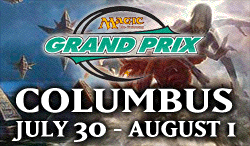We have the brackets. Play has begun, both online and off. This week, Cuneo Blue battles with Next Level Bant and Stompy goes up against Sabre Bargain. Plus, another request for help with this tournament.
What’s going on: I am going to run a tournament matching 32 of the best Standard legal decks of all time in a single elimination tournament. The idea is to find out if modern decks can run with the best historical decks. The event will play best of 5 matches, with 2 unsideboarded and up to three sideboarded matches. The decks chosen are a selection of the most famous historical decks, as played at the time.
The brackets and decklists can be found here.
Where possible, I’m playing these matches out online, on MTGO. It’s obviously not possible for some matches, of course, since many of these decks rely on cards that just don’t exist online. (Rishadan Port is a great example.) When necessary, I’ll end up playing these matches between my two accounts, but I’d prefer actual opponents. When I’m online and available, I’ll hang out in a room called UST. Just type “/join UST” in any window on MTGO.
Here are the brackets to date.
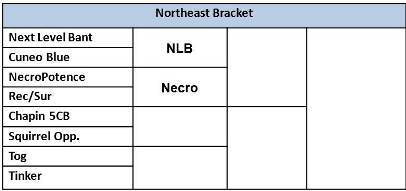
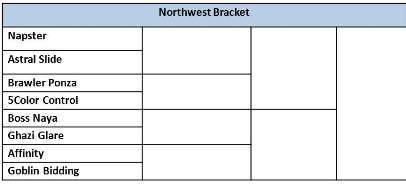
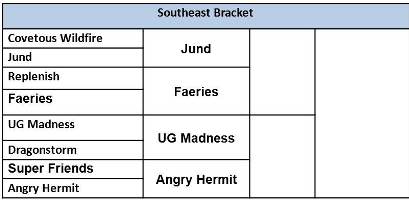
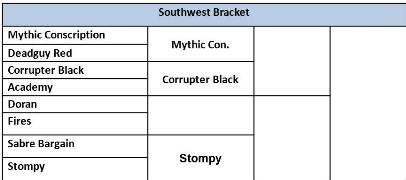
Misrecording and Pilot Error:
People have been complaining that I suck so badly that it invalidates the tournament. Sorry. I am the first to admit that I am a) not a pro, b) a semi-sloppy player, and c) playing decks I haven’t played, in some cases, for a decade. All I can do is repeat my request for assistance. Please, play me, or play these matches out with a friend. If you want to play this out with someone else, my only requirement is that you do what I do — record opening hands, and record every draw, every play, every ability activation and every life total change — at least all of those that are relevant. Then email me the results at pete
Thanks.
I took a lot of flak over some of the game play last week. In one Academy game, I must have misrecorded the game state: it looks like Academy could Intuition for Time Spiral turn 1 and use it. I didn’t — which does not mean I suck so badly I cannot count to nine. Something in the recap is not correct. Still my fault, but a different fault.
I don’t argue that I have made some questionable plays, especially in Academy. My opponent made some misplays with CB, and other decks. When we spot relevant mistakes, we do takebacks (except on MTGO, of course) and invalidate games where we messed up, but no game is ever perfect. Even games in the Top 8 at Pro Tours. I know — I have watched a lot of them.
I am not going to redo the match between Corrupter Black and Academy. CB did win several of those legitimately, and I am not going to go back and replay. Besides, people wanted Academy banned outright — now it’s out. If you don’t like that result, feel free to play Academy against CB yourself, then when we get the rest of the bracket filled in, play Academy against its opposition. I’m not going to.
Again — if you have time, can meet me online, or want to play out a matchup yourself, please do so. Just use the decklists here. I also keep the brackets on that page up to date — in other words, once a match is played, I’ll post that as “played,” and post the results after the article with the results goes up.
On to coverage.
Cuneo Blue versus Next Level Bant
This was the first time an old deck was completely outclassed by a modern deck. Randy Buehler won a Worlds with this deck, but it is massively underpowered today. Let’s compare some of the cards.
Card draw: Impulse & Whispers of the Muse versus Seagate Oracle and Jace, the Mind Sculptor
Man Lands: Stalking Stones versus Celestial Colonnade.
Creatures: Rainbow Efreet versus. Vengevine
Removal: Nevinyrral’s Disk and Quicksand versus O Ring, Path to Exile and Martial Coup
From the NB perspective, the matchup is simple. It just casts test spells — stuff like Noble Hierarch and Sea Gate Oracle — to draw out counters. Once Cuneo Blue runs out of counters, it drops a Planeswalker. Cuneo Blue has zero maindeck answers to Planeswalkers, and only Capsize in the board. A resolved Jace is pure card advantage that Cuneo Blue cannot stop. A resolved Elspeth is a game over — at best, Cuneo Blue can use Nev’s Disk to, in effect, Fog.
Vengevine is even stupider against CB than modern decks. CB cannot apply pressure, so NLB simply casts Vengevine, and waits to cast two creatures in a turn. Cuneo Blue cannot stop Vengevine in that case, and it cannot race it. At best, it can throw Stalking Stones in the way, or use multiple Quicksands — but those effects only work for a turn. Rainbow Efreet is not an answer, either. Maybe it could have been back when damage stacked, but not now.
The other big problem, for Cuneo Blue, is Celestial Colonnade. At best, Rainbow Efreet can Fog one every turn, but NLB has a lot of manlands.
Here’s a sample game.
NLB on the draw. It keeps an opening hand of Misty Rainforest, Forest, Sunpetal Grove, Noble Hierarch, Elspeth, Wall of Omens, Path.
CB: Island, go
NLB: Draw Sphinx of Lost Truths, play Forest, Noble Hierarch (fishing for Force Spike, but it resolves), go
CB: Island, go
NLB: draw Seagate Oracle, play Sunpetal Grove, beat for one. Play Wall of Omens. It resolves. Draw Bant Charm.
CB: Quicksand, go
NLB: draw and play Stirring Wildwood. Play Seagate Oracle, which is countered with Forbid, no buyback.
CB: Island, go
NLB: draw Ranger of Eos, play Rainforest and fetch an Island, activate Wildwood, beat for 4. CB plays Impulse * 2 EoT.
CB: Island, go
NLB: draw and play Seaside Citadel, activate Wildwood, beat for four.
CB: Island, play Nev’s Disk leaving UU up.
NLB: draw Wall of Omens, activate Wildwood, beat for four. (Disk is tapped)
CB: Stalking Stones, go
NLB: draw Celestial Colonnade, activate Wildwood using Noble Hierarch, declare attackers, CB blows the Disk. Path Hierarch in response, fetching Plains. (Could have tried Bant Charm on the Disk, but better to save it for later.) Second Main play Colonnade, CB casts Whispers of the Muse with buyback EoT.
CB: {no play}
NLD: draw Jace, activate Celestial Colonnade, attack. (CB at 4) CB Whispers with buyback EoT.
CB: draw, Whispers no buyback, concede.
Sideboarding does not really help Cuneo Blue. It gets the Wastelands to deal with the manlands, but nothing really deals with the Planeswalkers or Vengevine. NLB gets a couple Negates, the Mold Shambler, another Bant Charm, etc.
I played maybe a dozen games before sideboarding, to make sure I had a feel for the matchup. Cuneo Blue did a total of three damage, with an animated Stalking Stones, in all those matches. NLB did more damage to itself with its four painlands than CB could do.
NLB advances.
Sabre Bargain versus Stompy
Back in the day, I played Sabre Bargain a fair amount, and played against it a lot. However, that was ten years ago.
Conceptually, Sabre Bargain is easy to play. You play out lots of mana, play Academy Rector, tap everything to float all the mana you can, then play Renounce and sacrifice everything for lots of life. Then the Rector gets Yawgmoth’s Bargain, Bargain draws lots of cards and you play lots more mana. The kill is multiple Soul Feasts, which lets Bargain draw still more cards, and maybe a hit or two from Skirge Familiar. The deck also has Yawgmoth’s Will, which lets you re-use all that stuff you renounced, as well as allowing you to cast Soul Feasts again and again.
In practice, Sabre Bargain is a pain to play. It is basically a complex math problem — an equation with variables for white, black and colorless mana, cards in hand, lands played, cards in graveyard and life total.
Here’s an example:
It is the beginning of your turn 4. You are at 14 life.
You have, in play, a Peat Bog (1 counter), Remote Farm (two counters), Skull of Ramos, Plains, Swamp, Grim Monolith (untapped) and 2 Voltaic Keys. You have Dark Ritual, Yawgmoth’s Will and Renounce in hand. You draw the Academy Rector you Vampiric Tutored for at the end of your opponent’s last turn.
Go nuts.
Here’s the play, roughly. (Note, I’m doing this offhand, as an example. Hopefully I get it right.)
Tap Peat Bog (goes to graveyard) for BB
Tap Remote Farm and Plains: WWWBB
Cast Dark Ritual: WWWBBBB
Tap and sacrifice* Skull of Ramos: WWWBBBBBB
Tap Phyrexian Tower for 1: 1WWWBBBBBB
Tap Grim Monolith for 3, untap with Voltaic Key, tap Monolith for 3, untap it with Key number two: 8WWWBBBBBB
Cast Academy Rector: 5WWBBBBBB
Now you cast Renounce, sacrificing everything, gaining 14 life and fetching Yawgmoth’s Bargain when Rector dies. Now you can draw cards off Bargain. You have 28 life to play with, and 4WBBBBBB floating. Let’s assume you draw 24 cards. They include two Soul Feasts, a Skirge Familiar, another Dark Ritual, two Grim Monoliths and a Renounce. You cast the Ritual, the Monolith, than tap it to cast the other Monolith. You tap that to cast Skirge Familiar.
You are now have 2WBBBBBBB floating, 4 life and 2 Soul Feasts. You also have 21 cards in hand that can be discarded to the Skirge Familiar for mana.
You cast both Soul Feasts. You are now at 18 life. You draw 12 more cards. These include the third Voltaic Key, another Heart of Ramos, another Dark Ritual and another Soul Feast. You play the Key, untap and retap the Monolith, play the Ritual and cast Soul Feast. You still have lots of lands in hand — and the Yawgmoth’s Will.
One of the cards in hand is a Plains, so you play and tap it, then cast Renounce, sacrificing the Plains, the Key and both Monoliths. You again have 18 life.
You cast Yawgmoth’s Will.
From the graveyard, you cast all three Dark Rituals. Then you cast Monolith, tap it to play Key and untap it. Tap it again and cast another Monolith and another Key. Tap everything. Cast two Soul Feasts from the graveyard.
Your opponent has just sat there watching you play with yourself for a small eternity, and is now dead.
That’s not the whole story. Stompy does not just sit there. Stompy gets starts like this:
Turn 1: Forest, Wild Dogs
Turn 2: Rancor Dogs, beat for 4, Forest, Pouncing Jaguar
Turn 3: pay echo, play Gaea’s Cradle, Elvish Lyrist, Giant Growth, beat for 9.
Turn 4: beat with everything except Lyrist (keep it up to kill Bargain if that happens.) Cursed Scroll Sabre Bargain naming Treetop Village (only card in hand), play the Village. Sabre Bargain has now taken 21 damage, so unless it had Renounce, and mana to cast it, the game is over.
By the way, that is only an average draw for Stompy.
Now link the two games together. If Stompy is on the play, the game looks like this:
Turn 1:
Stompy: Forest, Wild Dogs
Bargain: Peat Bog
Turn 2:
Stompy: Rancor Dogs, beat for 4, Forest, Pouncing Jaguar
Bargain: Remote Farm, Monolith, Key, Skull of Ramos
Turn 3:
Stompy: pay echo, play Gaea’s Cradle, Elvish Lyrist, Giant Growth, beat for 9.
Bargain: Swamp, Key, untap Monolith (Monolith did 1 during upkeep)
Turn 4:
Stompy: beat with everything except Lyrist (keep it up to kill Bargain if that happens.) Cursed Scroll Sabre Bargain naming Treetop Village (only card in hand), play the Village. Sabre Bargain has to sacrifice at least two permanents to Renounce to stay alive — three to have enough mana to Vampiric Tutor for Rector as well. Using the Renounce means that it cannot cast Rector and kill it, so it would have to Tutor for Bargain, then try to go off with almost no mana, no permanents and no life. Not going to happen.
If Sabre Bargain is on the play, it will get to go off turn 4. However, when it finally goes off, it will start the turn with 4 life. Renounce will get Bargain up to 18 life, but that is a lot riskier. If Bargain draws 17 cards, it may well get all the parts it needs, but it is iffy.
It took probably 15 practice games to get back to the point where I was proficient with Sabre Bargain. I didn’t have an opponent for those games — I was just relearning the combo, learning what to mulligan, etc. Towards the end, I was getting the deck to go off turn four through six — six was usually the result of a mulligan or two. I think turn 3 is possible, but it requires a god draw and a decent life total.
Once we got to playing for real, Stompy won every single game. A few games were close. Some came down to “if there is a Soul Feast or Yawgmoth’s Will in the next 5 or 7 cards, I win” — but there wasn’t. I think we played eight games before sideboarding – and I lost all eight.
Post board, Bargain gets three Perish and a Massacre. That’s really good against Mono-Green. Stompy gets another couple Orangutans and Thran Dynamo (a Feldon’s Cane that can fizzle Yawgmoth’s Will, and mess with Rector.) In both cases, though, the big question was what to take out. Bargain is a combo deck, and combo decks don’t like losing combo pieces. Stompy is pure beats, and the slowest beat is Cursed Scroll — but Cursed Scroll survives Perish.
In the end, Stompy brought in just the Orangs and two scrolls for an Elf, a Cursed Scroll, and two Giant Growths. Bargain brought in the hate for a set of one-ofs. (Best we could do. Yes, this could be a case of pilot error again — but it really was the best we could come up with.)
Post sideboard, Sabre Bargain needed to go three straight to pull out the win. Stompy, which started two up after pre-sideboard games, only needed to steal one game to take the match. I was willing to play a couple extra games, to try to compensate for possible pilot error on my part, and to see whether we had mis-sideboarded. It didn’t matter.
Stompy had no bad draws, and no mulligans. It did not flood, or draw inappropriate cards.
Sabre Bargain had no keepable seven card hands, and few keepable sixes. (For example, mulliganing this: 2 Peat Bog, 2 Swamp, Renounce, 2 Voltaic Key, into this: 2 Monolith, 2 Bargain, Will, Plains.) Bargain never saw a sideboard card when it mattered. (Seeing Massacre when Stompy has an Albino Troll with Rancor and a Treetop Village does not count.)
Back in the day, there were three ways of beating Sabre Bargain. You could deal a lot of damage quickly, leaving it too little life to go off. (Beatdown and RDW decks did this.) You could disrupt it. (Deck with targeted discard and mana disruption — like Replenish and Pirates — did this.) Or you could get lucky.
Stompy dealt a lot of damage, and it got lucky. This one was not a result of pilot error — once Stompy has taken its beats and is tapped out, the next turn becomes a Magic the Puzzling, and I have no qualms about discussing my last turn with opponents or spectators.
Stompy advances.
PRJ
“one million words” on MTGO

